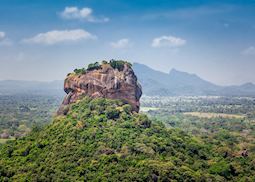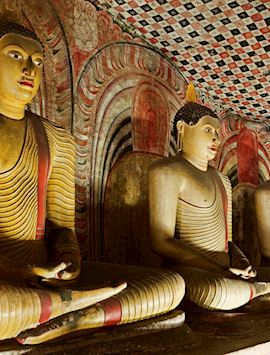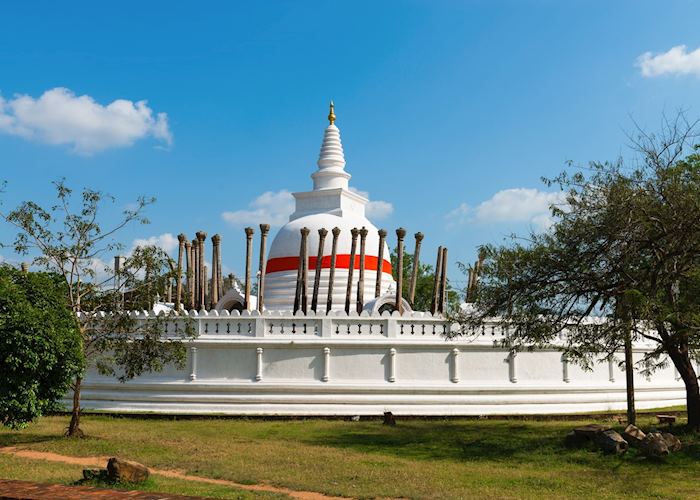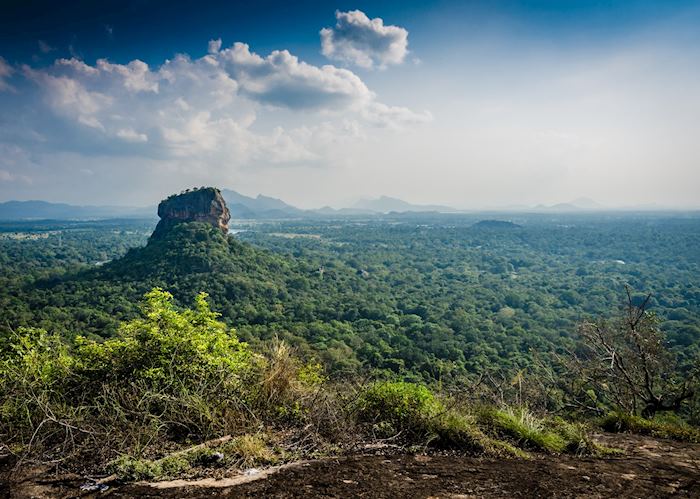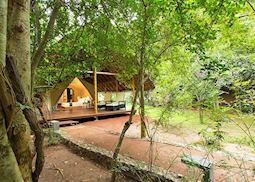Jump to:
In the fourth century, King Pandukabhaya chose the village of Anuradhapura as the capital of the Sinhalese people. It quickly bloomed into one of Asia’s great cities, with wealthy monastic complexes, hundreds of temples and a sophisticated irrigation system. Its main trio of dagobas (domed structures containing holy relics) were, at the time, only rivalled in size by the pyramids at Giza.
 This region in the north-central plains of Sri Lanka was known as Rajarata (Land of Kings), but it’s now called the Cultural Triangle. It encompasses the relics of the Sinhalese Kingdom from Anuradhapura, the later capital of Polonnaruwa and the revered cave temples of Dambulla. A range of hotels in the vicinity enable you to stay and explore — you’ll need at least three nights to do it justice.
This region in the north-central plains of Sri Lanka was known as Rajarata (Land of Kings), but it’s now called the Cultural Triangle. It encompasses the relics of the Sinhalese Kingdom from Anuradhapura, the later capital of Polonnaruwa and the revered cave temples of Dambulla. A range of hotels in the vicinity enable you to stay and explore — you’ll need at least three nights to do it justice.
Anuradhapura itself is a sprawling site with more temples, dagobas and monasteries than you could possibly see in a day. Some monuments lie in ruins, the tropical evergreen forest creeping between columns and statues of Buddha. Others have been restored and are still in use, and you’ll see monks robed in marigold-orange and pilgrims dressed in white performing protestations in front of the dagobas.
Many pilgrims then travel to nearby Mihintale, a mountainous outcrop believed to be the spot where Buddhism was introduced to Sri Lanka. It’s a long, steep climb to the top, but the stupas, statues and views across the surrounding plains are worth it.
Tussles for power were common, and during Anuradhapura’s early days, King Valagamba was forced to flee. He found sanctuary in a series of cave temples in the town of Dambulla. These caves became a place of royal worship, and were bestowed with detailed murals, statues and offerings. As you climb the 364 steps to reach the caves, you’re usually accompanied by pilgrims carrying offerings of flowers and fruit, and trailed by a few opportunistic monkeys.
In 933 AD, the South Indian Chola Empire ransacked Anuradhapura, and the capital was moved to nearby Polonnaruwa.
A more compact city than Anuradhapura, Polonnaruwa is easier to explore, and many of its temples, monasteries and palaces are still intact. Temple entrances are marked with finely carved moonstones, half-moon-shaped slabs of rock illustrated with lines of elephants and lions. Water remains in many of the stone water tanks, which were used for bathing and religious ceremonies.
 A short drive away is Sigiriya, which has become Sri Lanka’s calling card for visitors. This huge rock pokes out of the forested plains like a giant tooth, crowned with the remains of a royal palace and fortress from the short-lived Kassapa Kingdom.
A short drive away is Sigiriya, which has become Sri Lanka’s calling card for visitors. This huge rock pokes out of the forested plains like a giant tooth, crowned with the remains of a royal palace and fortress from the short-lived Kassapa Kingdom.
It’s a demanding 1,200 steps to the summit, but en route you’ll pass the Mirror Wall, scratched with the graffiti of pilgrims who tackled the climb more than 1,000 years ago. As you near the top, you walk through the giant stone paws of a lion (Sigiriya is Sinhalese for lion), which leads to the final staircase, and views across the plains.
Any existence of lions in Sri Lanka has never been proven (although the animal is prominent in ancient Sri Lankan folklore, art and architecture), but the Cultural Triangle does harbour elephants, sloth bears and leopards.
Three national parks, Minneriya, Kaudulla and Eco Park offer a change of scene from temple viewing. You can take a guided jeep safari through dry tropical forest, grasslands and wetlands, where you might sight spotted deer, langur monkeys, fish eagles or crocodiles.
The dense foliage makes leopards and sloth bears tricky to spot, but the elephants are usually easier to find. From July to October, elephants from across the island migrate to the park in an event known as the Gathering — the largest assembly of Asian elephants in the world.
Accessible Sri Lanka
Many of the Cultural Triangle’s best-known sights involve climbing long flights of stairs, or even ladders. Our specialists can suggest plenty of alternatives for a more accessible trip.
For example, we can advise you on the Aluvihare Rock Temple as an interesting (and quieter) alternative to the Dambulla Caves, with 13 caves at ground level, decorated with murals and statues. And, visiting Sigiriya could involve a tour of the surrounding Royal Gardens, a neatly landscaped area of terraces, pavilions, shrines and bathing pools. There’s also a small museum which shows a film of the views from the top.
Best time to visit the Cultural Triangle
For a small island, Sri Lankan weather patterns can be quite complicated. On planning a trip, we recommend discussing your interests with one of our specialists to help you decide on the best time to go. In general, the best time to visit the Cultural Triangle is from December to March when temperatures hover at a comfortable 27°C (80°F) and rainfall at its lowest.
who's been there

Start planning your tailor-made trip to the Cultural Triangle by contacting one of our Sri Lanka specialists
-
01993 838 92501993 838 335
- Make an enquiry
Places to visit in the Cultural Triangle
Featuring heavily on our experiences of visiting the Cultural Triangle, these selected places are destinations that also prove consistently popular with our travellers. Our specialists can help you choose how to include them in your wider trip, based on your preferences.
Suggested itineraries featuring the Cultural Triangle
Our itineraries will give you suggestions for what is possible when you travel in the Cultural Triangle, and they showcase routes we know work particularly well. Treat them as inspiration, because your trip will be created uniquely by one of our specialists.
Places in and around the Cultural Triangle
- Anuradhapura The Cultural Triangle
- Dambulla The Cultural Triangle
- Minneriya National Park The Cultural Triangle
- Polonnaruwa The Cultural Triangle
- Sigiriya The Cultural Triangle
- Pallepola 35 miles away
- Trincomalee 54 miles away
- Kandy 58 miles away
- Passikudah 68 miles away
- Nuwara Eliya 81 miles away
- Negombo 82 miles away
- Hatton 85 miles away
- Adam's Peak 91 miles away
- Horton Plains 92 miles away
- Bandarawela 94 miles away
- Colombo 98 miles away
- Wadduwa 111 miles away
- Udawalawe National Park 114 miles away
- Jaffna 115 miles away
- Sinharaja Biosphere 121 miles away
- Yala National Park 124 miles away
- Bentota 125 miles away
- Tangalle 146 miles away
- Galle 147 miles away
- The Southern Coast 152 miles away
Photos of the Cultural Triangle
Accommodation choices for the Cultural Triangle
We've selected a range of accommodation options for when you visit the Cultural Triangle. Our choices usually come recommended for their character, facilities and service or location. Our specialists always aim to suggest properties that match your preferences.
-
![Ulagalla Villa Plunge Pool]() Responsible ChoiceWe've hand-selected a range of tours and stays across the world that go above and beyond to be a force for good by supporting local businesses, educating staff, challenging local norms, or promoting conservation and biodiversity efforts. Your Responsible Choice helps increase the positive impact of your trip.
Responsible ChoiceWe've hand-selected a range of tours and stays across the world that go above and beyond to be a force for good by supporting local businesses, educating staff, challenging local norms, or promoting conservation and biodiversity efforts. Your Responsible Choice helps increase the positive impact of your trip.Ulagalla
Anuradhapura -
![Lake Lodge, Kandalama]()
Lake Lodge
Dambulla -
![Amaya Lake, Dambulla]()
Amaya Lake
Dambulla -
![Luxury Tent, Aliya Resort & Spa]()
Aliya Resort & Spa
Sigiriya -
![Vil Uyana, Sigiriya]()
Vil Uyana
Sigiriya -
![Panorama Bar, Water Garden Sigiriya]()
Water Garden Sigiriya
Sigiriya





